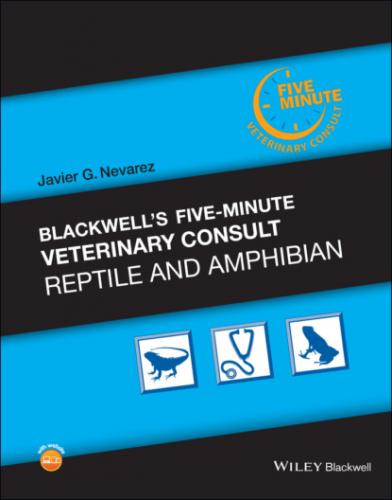NUTRITIONAL SUPPORT
Placement of an esophagostomy tube for feeding is recommended.
Maintain at appropriate temperature and humidity; exercise.
Caloric reduction with a nutritionally complete, low‐fat, high‐quality protein, liquid diet (Lafeber’s Emeraid®, EmerAid, LLC, Cornell, IL; Oxbow Critical Care®, Oxbow Animal Health, Omaha, NE; or Oxbow Carnivore Care®, Oxbow Animal Health, Omaha, NE).
Hydration
CLIENT EDUCATION/HUSBANDRY RECOMMENDATIONS
N/A
DRUG(S) OF CHOICE
Antibiotic of choice in reptiles if needed: ceftazidime.
Nutriceuticals such as silymarin and milk thistle are reported to be an anti‐ inflammatory and antioxidant; however, there are no studies to support claims for hepatic benefits.
PRECAUTIONS/INTERACTIONS
Avoid hepatotoxic agents in reptiles:
antibiotics: doxycycline, clindamycin, erythromycin
antivirals: acyclovir
antifungals: itraconazole, ketoconazole
antiparasitic: metronidazole, dichlorvos, tiabendazole, ivermectin
PATIENT MONITORING
Regular checkups to assess body weight, change in serum biochemistries, and possibly rebiopsy.
EXPECTED COURSE AND PROGNOSIS
After support through any acute crisis, the long‐term prognosis depends on associated conditions and whether these can be changed.
COMMENTS
N/A
ZOONOTIC POTENTIAL
N/A
SYNONYMS
Fatty liver
Vacuolar hepatopathy
ABBREVIATIONS
AST = aspartate aminotransferase
CT = computed tomography
HE = hematoxylin and eosin
LDH = lactate dehydrogenase
MRI = magnetic resonance imaging
POTZ = preferred optimal temperature zone
Suggested Reading
1 Divers SJ, Cooper JE. Reptile hepatic lipidosis. Semin Avian Exot Pet 2000;9(3):153–164.
2 Knotková Z, Dorrestein GM, Jekl V, et al. Fasting and postprandial serum bile acid concentrations in 10 healthy female red‐ eared terrapins (Trachemys scripta elegans). Vet Rec 2008;163(17):510–514.
3 Marchiori A, da Silva ICC, de Albuquerque Bonelli M, et al. Use of computed tomography for investigation of hepatic lipidosis in captive Chelonoidis carbonaria (spix, 1824). J Zoo Wildl Med 2015;46(2):320–324.
4 Martínez-Silvestre, A. Hepatic lipidosis in reptiles. Proc SEVC, October 2013, Barcelona, Spain.
5 West G. Endoscopic hepatic biopsy in Coahuilan box turtles, Terrapene coahuila. J Herpetol Med Surg 2001;11(2):28–29.
Author Drury R. Reavill, DVM, DABVP (Avian and Reptile & Amphibian Practice), DACVP
Herpesviruses
DEFINITION/OVERVIEW
HV are double‐stranded, enveloped DNA viruses. They can cause latent infections and infected animals can shed virus, in some cases without any clinical signs of disease. Infections are associated with various disease syndromes and clinical signs and severity of disease may depend on both the virus strain and the host species. Specific disease processes have been described in sea turtles and tortoises.
ETIOLOGY/PATHOPHYSIOLOGY
HV in the genus Scutavirushave been described in sea turtles, tortoises, and aquatic turtles.
HV infecting sea turtles include various strains of FPTHV, including chelonian chHV5, the type species of the genus Scutavirus, LEDV, and others.
Four different HV have been described in tortoises: testudinid HV 1–4. Transmission is most likely via direct contact.
In sea turtles, virus may survive for some time in sea water, and transmission via the environment may be possible.
Environmental stressors lead to more severe disease, and other infectious agents likely also contribute to the development of severe disease (e.g., mycoplasma infections in tortoises).
Animals that survive initial infection become carriers, and any animal that has been infected should be considered a lifelong carrier.
SIGNALMENT/HISTORY
Can affect all age classes
In sea turtles, fibropapillomatosis has been described in green (Chelonia mydas), loggerhead (Caretta caretta), hawksbill (Eretmochelys imbricata), and olive ridley (Lepidochelys olivacea) turtles around the world.
TeHV has been described in various tortoise species:TeHV1 most commonly in Russian tortoises (Testudo horsfieldii) in Asia and Europe.TeHV2 in California desert tortoises (Gopherus agassizii) in the USA.TeHV3 has been reported from a wide range of species, most commonly Mediterranean tortoise species (Testudospp.). Hermann’s (T. hermanni) and Russian tortoises appear to be highly susceptible to disease, while spur‐thighed (T. graeca) and marginated (T. marginata) tortoises survive disease more often and are more likely to become clinically inapparent carriers.TeHV4 has been described in a bowsprit tortoise (Chersina angluata) and a leopardtortoise (Stignochelys pardalis) in the USA and Europe (although both species are African in origin).
In aquatic turtles, HV have been described in various emydid species, including pond, painted, map, and box turtles as well as in other taxonomic groups of turtles.
Disease can occur year round, although tortoises may be particularly susceptible in the spring and fall.
CLINICAL PRESENTATION
Sea turtles
